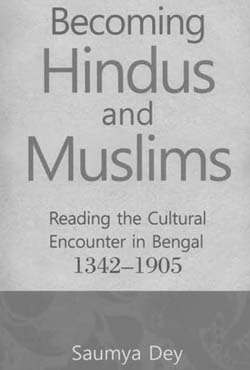Saumya Dey’s Becoming Hindus and Muslims tries to provide an alternative understanding of the growth of HinduMuslim identities in the region of Bengal. He challenges the understanding of historians that attributed primacy to the coming of colonialism in forming Indian identities like the ever so contested Hindu-Muslim identity. The book then wants to shatter the myth that prior to the arrival of colonialism Indians were not conscious of group labels like ‘Hindus’ and ‘Muslims’. Rather by tapping into the rich legacy of verse and prose composed throughout pre-colonial Bengal, Dey wants to show the process by which exclusive Hindu-Muslim identities came to be formed long before the colonial officials strode in with their separate cultural registers.
Dey’s main source material are the vernacular kavya tradition comprising Mangalkavyas and Vijayakavyas that became so popular in medieval Bengal. The kavyas of both Muslim and non-Muslim authorship evinced a vocabulary which was conscious of their distinct religious identities. Dey asserts there was not just a consciousness of identity but there was also a chasm between the two distinct cultural complexes. According to him, this tension was evident in these very texts where both the Hindu and the Muslim authors not just attempted to portray their religious belief as superior but also displayed anxieties over the steep challenge posed by the essentially ‘other’ competing religious beliefs.
The book also takes into consideration arguments made by the likes of Richard Eaton and Tony Stewart to name a few about the syncretic nature of Hindu-Muslim relations in the pre-colonial period. The author realized that there are numerous instances in the literature he has analysed where the cosmologies of the two religions have been fused. Dey himself gives examples like Daulat Qazi addressing Allah as Niranjan or characters emphasizing on the oneness of Allah and Ishvar. In this regard, the author believes though this might give the impression of harmony, in actuality this was not the case because even in such ‘syncretic narratives’ eventually there was always the case of one identity subsuming and silencing the other and it is the narrative of conflict and conversion which remains dominant.
While the text is indeed valuable for bringing into the light of historical examination works like Mangalkavyas which have been always sidelined as valid sources for his torical enquiry, Dey’s work has shown how texts characterized as a historic can serve as crucial tools for analysing issues like identity formation. However, belonging to a preprint culture, it is equally important to be very careful when dealing with manuscripts that Dey has worked with. These manuscripts were copied by hand as it was the only means of transmitting the knowledge embedded within these narratives. This produced several manuscripts of the same narrative and often there were mistakes while copying; spelling errors, additions and omissions which resulted in transforming the very meaning of these narratives. Dey has often used only single manuscripts of such texts to reach a conclusion suiting his narrative. Whereas, if he had been careful in considering multiple versions, he could have arrived at more nuanced understandings of the passages/verses he analysed maybe further problematizing the central argument around which his text has been composed.

